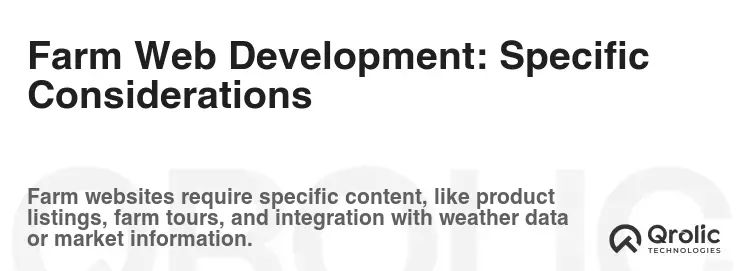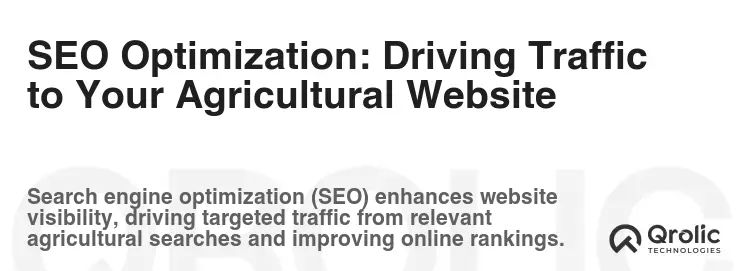Agriculture, a sector rooted in tradition and hard work, is rapidly evolving. In today’s digital age, a strong online presence is no longer a luxury but a necessity for agricultural businesses to thrive. A well-designed website acts as a virtual storefront, connecting farms, ranches, and agribusinesses with customers, suppliers, and partners across the globe. This comprehensive guide explores the nuances of website design for agricultural businesses, covering everything from the foundational elements to advanced strategies for achieving online success.
Table of Contents
- Why Your Agricultural Business Needs a Website
- Reaching a Wider Audience
- Building Credibility and Trust
- Enhancing Communication and Customer Service
- Streamlining Operations and Reducing Costs
- Staying Competitive in the Digital Age
- Key Elements of Effective Agricultural Website Design
- Visual Appeal and Branding
- User-Friendly Navigation
- Informative and Engaging Content
- E-Commerce Functionality (If Applicable)
- SEO Optimization for Visibility
- Farm Web Development: Specific Considerations
- Showcasing Your Farm
- Promoting Farm-Fresh Products
- Connecting with the Community
- Agribusiness Website Design: Tailored Strategies
- Showcasing Your Services
- Building Relationships with Suppliers and Buyers
- Promoting Value-Added Products
- Website Design Process: A Step-by-Step Guide
- 1. Define Your Goals and Objectives
- 2. Conduct Market Research and Competitive Analysis
- 3. Plan Your Website Structure and Content
- 4. Choose a Domain Name and Hosting Provider
- 5. Design Your Website
- 6. Develop Your Website
- 7. Test Your Website
- 8. Launch Your Website
- 9. Maintain and Update Your Website
- SEO Optimization: Driving Traffic to Your Agricultural Website
- Keyword Research
- On-Page Optimization
- Off-Page Optimization
- Local SEO
- Measuring Success: Website Analytics and Reporting
- Website Traffic
- Conversion Rates
- User Engagement
- Reporting
- Qrolic Technologies: Your Partner in Agricultural Website Design
- Our Services
- Why Choose Qrolic Technologies?
Why Your Agricultural Business Needs a Website

Before diving into the design process, let’s understand why a website is crucial for modern agricultural businesses:
Reaching a Wider Audience
- Expanding Market Reach: A website transcends geographical boundaries, allowing you to reach potential customers far beyond your local community.
- Attracting New Customers: By showcasing your products and services online, you can tap into a vast pool of potential customers actively searching for what you offer.
- Global Market Access: If you’re looking to export your products, a website provides a platform to connect with international buyers and distributors.
Building Credibility and Trust
- Establishing Authority: A professional website demonstrates your commitment to quality and innovation, establishing you as a reputable player in the agricultural industry.
- Showcasing Expertise: Use your website to share your knowledge, expertise, and best practices, building trust with your audience.
- Transparency and Accountability: Provide detailed information about your farming practices, certifications, and quality control measures to build trust and transparency.
Enhancing Communication and Customer Service
- 24/7 Availability: Your website is always online, providing customers with access to information and resources at their convenience.
- Answering Common Questions: Address frequently asked questions on your website to save time and improve customer satisfaction.
- Providing Customer Support: Offer online support through contact forms, email, or live chat to address customer inquiries promptly.
Streamlining Operations and Reducing Costs
- Online Ordering and Sales: Implement e-commerce capabilities to allow customers to place orders online, streamlining your sales process.
- Automated Communication: Use email marketing to automate communication with customers, keeping them informed about new products, promotions, and industry news.
- Reduced Marketing Expenses: Online marketing is often more cost-effective than traditional advertising methods, allowing you to reach a wider audience with a smaller budget.
Staying Competitive in the Digital Age
- Meeting Customer Expectations: Today’s customers expect businesses to have an online presence. A website demonstrates that you’re keeping up with the times.
- Competing with Larger Companies: A well-designed website can help level the playing field, allowing smaller agricultural businesses to compete with larger corporations.
- Staying Ahead of the Curve: Embrace technology and innovation to stay ahead of the competition and adapt to the evolving needs of the agricultural industry.
Key Elements of Effective Agricultural Website Design

Designing a website for an agricultural business requires a unique approach, considering the specific needs and challenges of the industry. Here are the key elements to focus on:
Visual Appeal and Branding
- Professional Design: Invest in a visually appealing and professional website design that reflects the quality of your products and services.
- High-Quality Photography and Videography: Use stunning visuals to showcase your farm, products, and processes.
- Consistent Branding: Maintain a consistent brand identity across your website, including your logo, colors, and typography.
- Mobile Responsiveness: Ensure your website is mobile-friendly and responsive, providing a seamless experience for users on all devices.
User-Friendly Navigation
- Intuitive Menu Structure: Create a clear and intuitive menu structure that allows visitors to easily find the information they’re looking for.
- Search Functionality: Implement a search function that allows users to quickly search for specific products, services, or information.
- Clear Call-to-Actions: Use clear and concise call-to-actions to guide visitors towards desired actions, such as contacting you, requesting a quote, or placing an order.
- Fast Loading Speed: Optimize your website for speed to ensure a smooth and enjoyable user experience.
Informative and Engaging Content
- Compelling Storytelling: Share your farm’s story, highlighting your values, traditions, and commitment to quality.
- Detailed Product Descriptions: Provide detailed information about your products, including ingredients, nutritional information, and usage instructions.
- Educational Resources: Offer valuable educational resources, such as articles, guides, and videos, to educate your audience about agriculture and your specific products.
- Customer Testimonials: Include customer testimonials to build trust and credibility.
E-Commerce Functionality (If Applicable)
- Secure Payment Gateway: Integrate a secure payment gateway to ensure safe and reliable online transactions.
- Easy-to-Use Shopping Cart: Provide an easy-to-use shopping cart that allows customers to easily add and remove items.
- Clear Shipping and Return Policies: Clearly outline your shipping and return policies to avoid confusion and build trust.
- Inventory Management: Implement an inventory management system to track your stock levels and avoid overselling.
SEO Optimization for Visibility
- Keyword Research: Conduct thorough keyword research to identify the terms your target audience is using to search for agricultural products and services.
- On-Page Optimization: Optimize your website’s content, meta descriptions, and image alt tags with relevant keywords.
- Off-Page Optimization: Build high-quality backlinks from other reputable websites in the agricultural industry.
- Local SEO: Optimize your website for local search to attract customers in your area.
Farm Web Development: Specific Considerations

Farm web development requires a nuanced approach that considers the unique challenges and opportunities of the agricultural sector. Here are some specific considerations:
Showcasing Your Farm
- Virtual Farm Tour: Create a virtual tour of your farm, allowing visitors to experience your operations firsthand.
- Behind-the-Scenes Content: Share behind-the-scenes content, such as videos and photos of your farming practices, to build transparency and connect with your audience.
- Highlighting Sustainable Practices: Emphasize your commitment to sustainable farming practices, such as organic farming, water conservation, and soil health.
- Meet the Farmer: Introduce yourself and your team, sharing your passion for agriculture and your dedication to providing high-quality products.
Promoting Farm-Fresh Products
- Seasonal Product Offerings: Highlight seasonal product offerings, showcasing the freshest produce available at different times of the year.
- Farm-to-Table Story: Tell the story of your farm-to-table journey, emphasizing the connection between your farm and the food that ends up on consumers’ plates.
- Recipe Ideas: Provide recipe ideas that showcase your products and inspire customers to cook with fresh, local ingredients.
- Online Farm Store: Create an online farm store where customers can purchase your products directly from your farm.
Connecting with the Community
- Events Calendar: Promote upcoming farm events, such as harvest festivals, farmers’ markets, and educational workshops.
- Community Involvement: Highlight your involvement in the local community, such as supporting local charities and organizations.
- Partnerships with Local Businesses: Showcase your partnerships with other local businesses, such as restaurants, retailers, and distributors.
- Blog and News Section: Share news and updates about your farm, the agricultural industry, and your community.
Agribusiness Website Design: Tailored Strategies

Agribusiness websites require a different set of strategies than farm websites, focusing on the specific needs of businesses involved in the processing, distribution, and marketing of agricultural products. Here are some tailored strategies:
Showcasing Your Services
- Detailed Service Descriptions: Provide detailed descriptions of your services, including processing, packaging, transportation, and storage.
- Case Studies: Showcase successful case studies, demonstrating your expertise and track record.
- Certifications and Accreditations: Highlight your certifications and accreditations, such as ISO certifications and food safety certifications.
- Equipment and Technology: Showcase your state-of-the-art equipment and technology, emphasizing your commitment to innovation and efficiency.
Building Relationships with Suppliers and Buyers
- Supplier Portal: Create a supplier portal where suppliers can access information about your procurement policies, quality standards, and payment terms.
- Buyer Portal: Create a buyer portal where buyers can access information about your products, pricing, and availability.
- Industry News and Insights: Share industry news and insights to keep your suppliers and buyers informed about the latest trends and developments.
- Contact Information for Key Personnel: Provide contact information for key personnel in your sales, procurement, and customer service departments.
Promoting Value-Added Products
- Highlighting Unique Selling Points: Highlight the unique selling points of your value-added products, such as their quality, taste, and nutritional benefits.
- Product Packaging and Branding: Showcase your product packaging and branding, emphasizing their appeal and shelf presence.
- Marketing Materials: Provide downloadable marketing materials, such as brochures, flyers, and product sheets, to support your buyers’ sales efforts.
- Trade Show Information: Promote your participation in industry trade shows, inviting potential buyers to visit your booth.
Website Design Process: A Step-by-Step Guide

Designing a website for your agricultural business can seem daunting, but by following a structured process, you can ensure a successful outcome. Here’s a step-by-step guide:
1. Define Your Goals and Objectives
- What do you want to achieve with your website? (e.g., increase sales, generate leads, build brand awareness)
- Who is your target audience? (e.g., consumers, retailers, distributors)
- What are your key performance indicators (KPIs)? (e.g., website traffic, conversion rates, sales revenue)
2. Conduct Market Research and Competitive Analysis
- Identify your competitors: Analyze their websites to identify their strengths and weaknesses.
- Understand your target audience: Research their needs, preferences, and online behavior.
- Identify industry trends: Stay up-to-date on the latest trends in agricultural website design and online marketing.
3. Plan Your Website Structure and Content
- Create a sitemap: Outline the structure of your website, including the pages and subpages you will need.
- Develop a content strategy: Plan the content for each page, including text, images, and videos.
- Write compelling copy: Use clear, concise, and engaging language to communicate your message.
4. Choose a Domain Name and Hosting Provider
- Select a domain name: Choose a domain name that is relevant to your business and easy to remember.
- Choose a hosting provider: Select a reliable hosting provider that offers the features and performance you need.
5. Design Your Website
- Create a visual design: Develop a visually appealing and professional website design that reflects your brand.
- Ensure mobile responsiveness: Make sure your website is mobile-friendly and responsive.
- Optimize for speed: Optimize your website for speed to ensure a smooth user experience.
6. Develop Your Website
- Hire a professional web developer: Consider hiring a professional web developer to build your website.
- Use a website builder: Alternatively, you can use a website builder like WordPress, Wix, or Squarespace to build your own website.
7. Test Your Website
- Test your website thoroughly: Test your website on different devices and browsers to ensure it works properly.
- Get feedback from users: Ask friends, family, and colleagues to test your website and provide feedback.
8. Launch Your Website
- Promote your website: Promote your website through online marketing channels, such as search engine optimization (SEO), social media marketing, and email marketing.
- Monitor your website: Monitor your website’s performance and make adjustments as needed.
9. Maintain and Update Your Website
- Keep your website updated: Regularly update your website with fresh content and new features.
- Monitor security: Monitor your website for security vulnerabilities and take steps to protect it.
- Back up your website: Regularly back up your website to prevent data loss.
SEO Optimization: Driving Traffic to Your Agricultural Website

Search engine optimization (SEO) is crucial for driving traffic to your agricultural website. Here are some key SEO strategies:
Keyword Research
- Identify relevant keywords: Use keyword research tools to identify the keywords that your target audience is using to search for agricultural products and services.
- Target long-tail keywords: Target long-tail keywords, which are longer and more specific phrases, to attract a more targeted audience.
- Analyze competitor keywords: Analyze your competitors’ websites to identify the keywords they are targeting.
On-Page Optimization
- Optimize title tags and meta descriptions: Use relevant keywords in your title tags and meta descriptions to improve your website’s search engine rankings.
- Optimize content with keywords: Incorporate relevant keywords into your website’s content, including headings, body text, and image alt tags.
- Use internal linking: Use internal linking to connect different pages on your website and improve its overall SEO.
Off-Page Optimization
- Build high-quality backlinks: Build high-quality backlinks from other reputable websites in the agricultural industry.
- Participate in online communities: Participate in online communities, such as forums and social media groups, to build relationships and promote your website.
- Submit your website to directories: Submit your website to relevant online directories to increase its visibility.
Local SEO
- Claim your Google My Business listing: Claim your Google My Business listing and optimize it with relevant information about your business.
- Get local citations: Get local citations from other websites in your area, such as local directories and business review sites.
- Encourage customer reviews: Encourage customers to leave reviews on your Google My Business listing and other review sites.
Measuring Success: Website Analytics and Reporting

Measuring the success of your website is crucial for identifying areas for improvement and maximizing your return on investment. Here are some key metrics to track:
Website Traffic
- Overall traffic: Track the overall traffic to your website to see how many people are visiting it.
- Traffic sources: Identify the sources of your website traffic, such as search engines, social media, and referral websites.
- Pageviews: Track the number of pageviews to see which pages are most popular.
- Bounce rate: Monitor your bounce rate to see how many people are leaving your website after viewing only one page.
Conversion Rates
- Lead generation: Track the number of leads generated through your website, such as contact form submissions and email sign-ups.
- Sales conversions: Track the number of sales conversions generated through your website, such as online orders and product inquiries.
- Click-through rates: Monitor your click-through rates on call-to-action buttons and links.
User Engagement
- Time on site: Track the average time spent on your website to see how engaged visitors are.
- Pages per session: Monitor the number of pages viewed per session to see how deeply visitors are exploring your website.
- Social shares: Track the number of social shares to see how often your content is being shared on social media.
Reporting
- Use analytics tools: Use analytics tools like Google Analytics to track your website’s performance.
- Create regular reports: Create regular reports to summarize your website’s performance and identify areas for improvement.
- Share reports with stakeholders: Share your reports with stakeholders to keep them informed about your website’s progress.
Qrolic Technologies: Your Partner in Agricultural Website Design

Qrolic Technologies (https://qrolic.com/) understands the unique challenges and opportunities of the agricultural industry. We are a leading provider of website design and digital marketing services, specializing in helping agricultural businesses thrive online.
Our Services
- Custom Website Design: We create custom website designs that are tailored to your specific needs and brand.
- E-Commerce Solutions: We develop e-commerce solutions that allow you to sell your products online securely and efficiently.
- SEO Optimization: We optimize your website for search engines to drive more traffic and generate more leads.
- Digital Marketing: We provide a full range of digital marketing services, including social media marketing, email marketing, and pay-per-click advertising.
Why Choose Qrolic Technologies?
- Industry Expertise: We have extensive experience working with agricultural businesses of all sizes.
- Customized Solutions: We develop customized solutions that are tailored to your specific needs and goals.
- Results-Driven Approach: We are committed to delivering results that help you grow your business.
- Dedicated Support: We provide dedicated support to ensure your website is always running smoothly.
Contact Qrolic Technologies today to learn how we can help you cultivate online success for your agricultural business. Let us help you plant the seeds for a flourishing digital presence.






